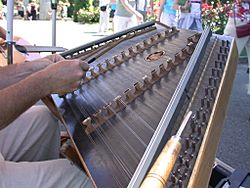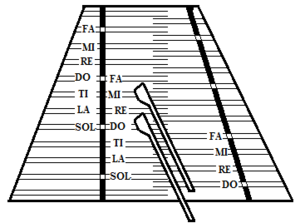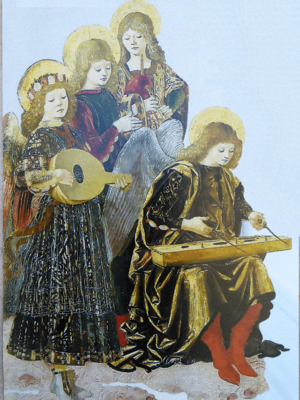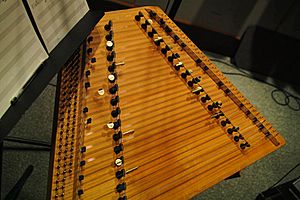Hammered dulcimer facts for kids

A musician playing a diatonic hammered dulcimer
|
|
| String instrument | |
|---|---|
| Other names | Cimbalom Dulcimer Four-hammer dulcimer Hammer dulcimer de: Hackbrett it: Salterio es: Dulcémele uk: Tsymbaly cs: Cimbal pl: Cymbały fa: Santoor, Santur fr: Tympanon zh: Yangqin ko: Yanggeum kh: ឃឹម Khim vi: Tam Thập Lục th: ขิม Khim tt: чимбал çimbal |
| Classification | Percussion instrument (chordophone), string instrument |
| Hornbostel–Sachs classification | 314.122-4 (Simple chordophone sounded by hammers) |
| Developed | Antiquity |
| Related instruments | |
| Alpine zither, Appalachian dulcimer, autoharp, board zither, concert zither, Psaltery, Tambourine de Bearn | |
The hammered dulcimer is a musical instrument with strings. It has a special shape, usually like a trapezoid. The strings are stretched over a wooden sound board.
Musicians play the hammered dulcimer by hitting its strings. They use small, spoon-shaped mallets called hammers. The word dulcimer means "sweet song." It comes from old Latin and Greek words. This instrument came from the psaltery, which is an instrument where strings are plucked instead of hit.
Hammered dulcimers are played all over the world. You can find them in places like Iraq, India, China, and many parts of Europe. They are also popular in the United Kingdom and the United States. In the US, this instrument became very popular again in folk music in the late 1900s.
Contents
How the Hammered Dulcimer Works
A dulcimer usually has two wooden parts called bridges. These bridges hold up the strings. One bridge is for lower notes (bass strings) and the other is for higher notes (treble strings). You can play the treble strings on both sides of their bridge. Playing on one side gives a different note than playing on the other.
Dulcimers come in different sizes. Their size is often described by how many strings cross each bridge. For example, a "15/14" dulcimer has 15 strings on the treble bridge and 14 on the bass bridge. This size can play notes across three octaves.
Most hammered dulcimers have strings in pairs. This means two strings are used for each note. Sometimes there are three or four strings per note. All strings for one note are tuned to sound exactly the same. Using multiple strings makes the instrument louder. It also creates a cool, slightly wavy sound called a chorus effect.
Like a piano, a hammered dulcimer needs a special tool to tune it. This tool is called a tuning wrench. It turns small pins that hold the strings tight.
Tuning the Strings
The strings on a hammered dulcimer are often tuned in a special pattern. This pattern is based on something called the circle of fifths. This tuning makes it easier to play different musical scales.
When you play notes in order, they go up the instrument in a repeating pattern. This pattern helps musicians play diatonic scales easily. A diatonic scale is like the "Do-Re-Mi-Fa-Sol-La-Ti-Do" scale you might know.
Sometimes, a dulcimer might not have all the notes of a chromatic scale. A chromatic scale includes every single note, black and white keys on a piano. To fix this, some modern dulcimers have extra short bridges. These bridges hold strings for the missing notes. These instruments are called "chromatic dulcimers." Regular ones are called "diatonic dulcimers."
In the English-speaking world, many hammered dulcimers have special marks on their bridges. These marks help players find the notes. An American player and maker named Sam Rizzetta started using these marks in the 1960s.
In the Alps, there are also chromatic dulcimers with strings that cross over each other. This special "Salzburger hackbrett" was created in the 1930s. It was even taught in music schools after World War II.
Hammers for Playing
The instrument is called "hammered" because of the small mallets used to hit the strings. These mallets are called hammers. Hammers are usually made of wood. Hardwoods like maple or oak are common. But they can also be made from metal or plastic.
In Western countries, hammers are usually stiff. But in Asia, flexible hammers are often used. The part of the hammer that hits the string can be bare wood. This makes a sharp sound. Or it can be covered with tape, leather, or fabric. This makes a softer sound.
Some hammers have two sides. One side might be bare wood, and the other side might be covered in a soft material like piano felt. This gives players different sound options.
Some traditional players used very unique hammers. Paul Van Arsdale from New York used flexible hammers made from hacksaw blades. These had leather-covered wooden blocks on the ends. An Irish player named John Rea made his hammers from thick steel wire. He wrapped them with wool. Billy Bennington from England used cane hammers wrapped with wool.
How the Dulcimer Led to the Piano
The hammered dulcimer was very popular in Europe during the Middle Ages. It had different names in different countries. But it was always seen as a type of psalterium.
People later realized how important it was that the dulcimer's strings were hit with hammers. This hitting action made a big difference in the instrument's sound. This idea became very important when the pianoforte was invented.
The psalterium, where strings were plucked, led to instruments like the harpsichord. But the dulcimer, where strings were struck, led to the creation of the pianoforte. The piano and harpsichord sound very different because of how their strings are played.
Hammered Dulcimers Around the World
Many different versions of the hammered dulcimer exist around the world. Each one has its own special way of being built and played:
- Afghanistan – santur
- Austria – Hackbrett
- Bangladesh – santoor
- Belarus – tsymbaly (цымбалы)
- Belgium – hakkebord
- Brazil – saltério
- Cambodia – khim
- Canada – hammered dulcimer
- China – yangqin (扬琴, formerly 洋琴)
- Croatian – cimbal, cimbale, cimbule
- Czech Republic – cimbál
- Denmark – hakkebræt
- France – tympanon
- Germany – Zymbal, Hackbrett
- Greece – Σαντούρι
- Hungary – cimbalom
- India – santoor
- Iran – santur
- Iraq – santur
- Ireland – tiompan
- Israel – דולצימר פטישים
- Italy – salterio
- Japan – darushimaa (ダルシマー)
- Korea – yanggeum (양금)
- Laos – khim
- Latgalia (Latvia) – cymbala
- Latvia – cimbole
- Lithuania – cimbalai, cimbolai
- Mexico – salterio
- Mongolia – yoochin (ёочин or ёчин)
- Netherlands – hakkebord
- Norway – hakkebrett
- Pakistan – santoor
- Poland – cymbały
- Portugal – saltério
- Romania – ţambal
- Russia – цимбалы, dultsimer (дульцимер)
- Serbia – цимбал (tsimbal)
- Slovakia – cimbal
- Slovenia – cimbale, oprekelj
- Spain (and Spanish-speaking countries) – salterio, dulcémele
- Sweden – hackbräde, hammarharpa
- Switzerland – Hackbrett
- Thailand – khim
- Turkey – santur
- Tibet - rgyud-mang (རྒྱུད་མང་, literally "many strings")
- Ukraine – tsymbaly (цимбали)
- United Kingdom – hammered dulcimer
- United States – hammered dulcimer
- Uzbekistan – chang
- Vietnam – đàn tam thập lục (lit. "36 strings")
- Yiddish – tsimbl
See also
- List of hammered dulcimer players
- Santoor – India
- Santurs from around the world
- Yangqin – China
- Santouri – Greece






